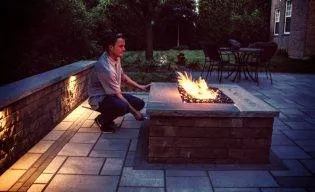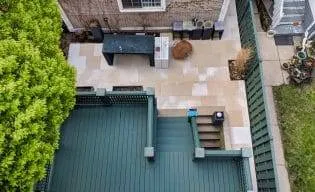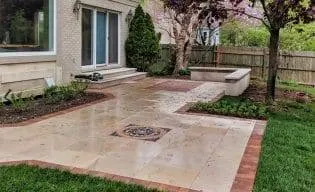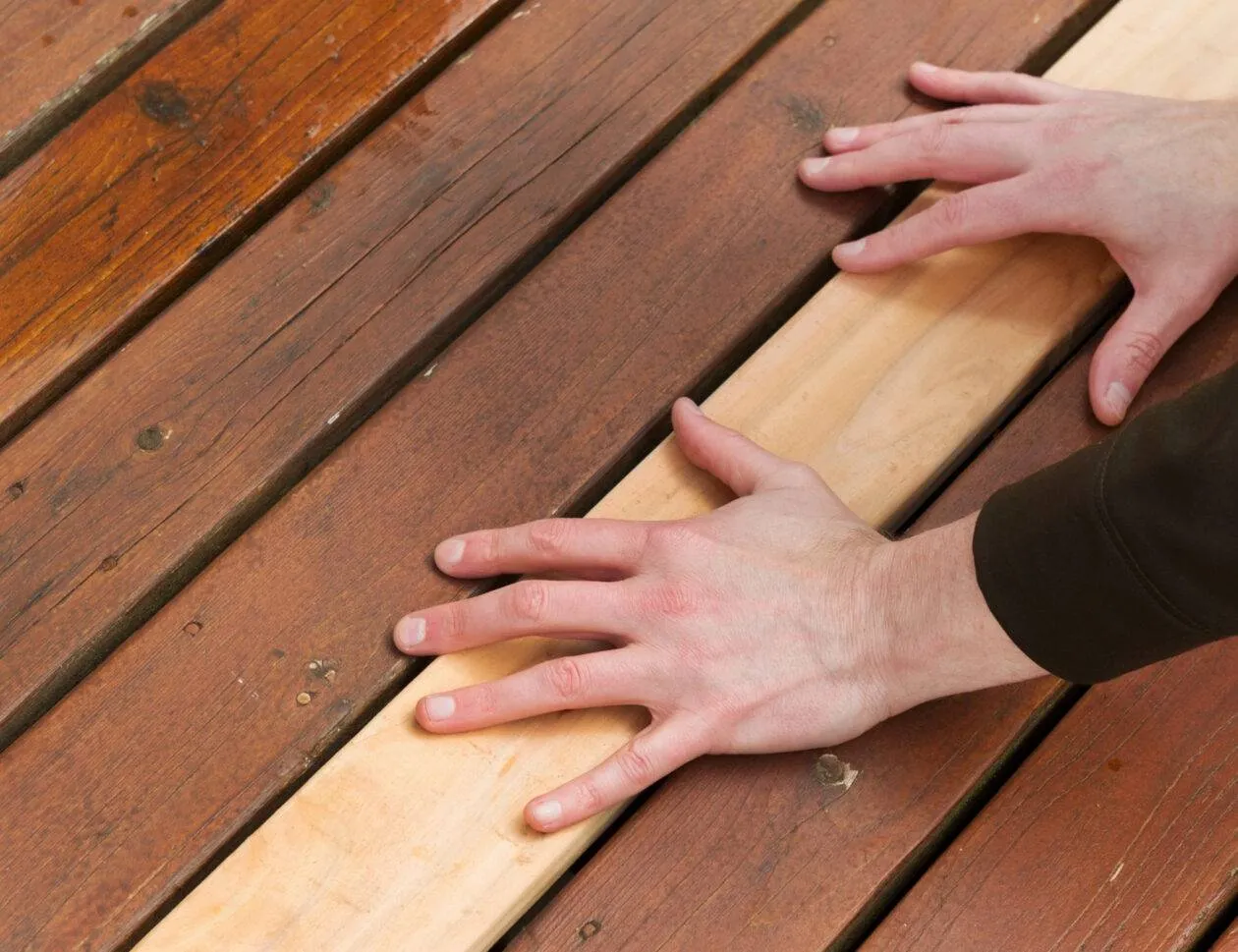Lightscaping transforms ordinary yards into captivating nighttime environments. When you invest in professional outdoor lighting, you create visual depth, improve safety, and extend the usable hours of your outdoor spaces. This guide covers what you need to know about selecting lighting types, working with installation professionals, and maintaining your system.
Wave Outdoors works with licensed electricians who handle everything from subtle accent fixtures to comprehensive lighting systems. The equipment we install resists weather damage, operates safely, and carries industry-leading warranties. Our landscape designers coordinate with electricians to ensure light integrates seamlessly with existing hardscape and softscape features.
What Lightscaping Means for Your Property
Lightscaping refers to the strategic placement of weather-resistant fixtures throughout residential or commercial landscapes. This process requires coordination between design vision and electrical expertise. When landscape lighting contractors understand both aesthetics and technical requirements, they create systems that highlight architectural features, define pathways, and establish ambiance.
The right lightscape design considers your property's unique characteristics. A skilled outdoor lighting installer evaluates sight lines, focal points, and functional needs before recommending specific fixtures and placement patterns.
Interested In Lightscaping Services ?
Choosing Power Sources for Exterior Lightin
Your power source affects installation complexity, operating costs, and lighting capabilities. Four primary options serve different purposes:
Solar fixtures require no wiring and cost nothing to operate. They work well for pathway markers and accent pieces in areas with consistent sun exposure. Solar works less reliably in shaded locations or during extended cloudy periods.
Low voltage systems operate at 12-24 volts, making them safer and simpler to install than line voltage alternatives. LED low voltage fixtures deliver excellent illumination while consuming minimal power. These systems excel at highlighting plants, trees, and architectural details.
Line voltage lighting runs on standard 120-volt household current. These fixtures produce more intense light and work best for illuminating large areas. Installation requires a licensed electrician and often involves trenching or conduit work.
Fuel-burning fixtures like torches and lanterns create ambiance through open flame. They need careful placement away from flammable materials and regular fuel replenishment.
Types of Outdoor Lighting Applications
Different lighting applications solve specific problems across the various areas of your property that need to be illuminated:
Accent lighting draws attention to specimen plants, water features, sculptures, or interesting architectural elements. Spotlights and well lights typically handle accent applications. Position these fixtures at ground level to project upward onto trees and architectural plantings. Adjustable fixtures allow you to redirect beams as plants grow and mature.
Architectural lighting emphasizes your home's design features and creates curb appeal. Uplights can showcase columns or interesting facade textures. Wall-mounted fixtures highlight entryways and create welcoming approaches. Consider your architectural style when selecting fixtures—contemporary homes suit clean-lined fixtures while traditional architecture pairs with classic lantern styles.
Sports court lighting makes evening basketball games or tennis matches possible. These installations require significant light output and even coverage across playing surfaces. Proper placement prevents shadows and glare that interfere with play.
Pool area lighting improves safety around water features while creating relaxing atmospheres. This application requires specialty waterproof fixtures rated for wet locations. Underwater fixtures illuminate pool interiors while above-water lighting handles decks and furniture areas. Under-cap hardscape lights tuck beneath masonry walls and supply subtle highlights around pool perimeters. Color-changing LED options allow customization for different moods. Safety remains the top priority when illuminating areas near water.
Patio, deck, and gazebo lighting extends outdoor living hours and creates inviting spaces for entertaining. Overhead fixtures provide general illumination while accent lights create mood. Installing deck lights often involves recessed fixtures that stay flush with walking surfaces to prevent tripping hazards. For pergolas and gazebos, ultra-thin recessed lights less than an inch thick install easily using spring clip mechanisms without requiring traditional cans. String lights and festoon lighting create ambiance for entertainment areas, while pendant lights and chandeliers bring indoor elegance outdoors when properly rated for wet or damp locations.
Pathway and walkway lighting prevents trips and falls while guiding visitors along intended routes. Low-profile fixtures mark edges without creating glare. Standard path lights stand 12-24 inches tall and space 8-15 feet apart depending on beam spread. For continuous illumination along flat paths, fixtures with 16-foot beam spreads typically space about 16 feet apart, while narrower beams require closer placement. Consider low voltage LED path lights for energy efficiency and simplified installation.
Driveway lighting needs consistent illumination from edge to entry. Bollard lights work well along driveway edges, providing visibility while creating a welcoming entrance. These fixtures typically stand 16-30 inches tall and offer 360-degree light distribution. For curved driveways, staggered placement on alternating sides maintains even coverage. Paired bollards flanking gates or driveway entrances establish formal entry points while providing practical illumination.
Step and stairway lighting requires dedicated illumination to prevent accidents at grade changes. Recessed step lights mount flush with risers, illuminating each tread without creating glare. Step riser lights supply subtle highlights and can deliver soft ambiance while improving safety. These specialty fixtures need proper waterproofing and impact resistance since they're frequently stepped near.
Motion-activated security lighting deters intruders and alerts you to activity. These fixtures stay dark until movement triggers them, covering vulnerable entry points like side yards and back doors. Adjust sensitivity to prevent false triggers from animals while maintaining security effectiveness. Dark corners around properties attract unwanted visitors, making strategic placement essential.
Inground fixtures sit flush with ground level and project light upward. They create dramatic effects when aimed at trees or architectural features. Also called well lights, these powerful fixtures provide exceptional brightness and work well for accentuating pergolas and surrounding landscape elements. Available in both single color and color-changing varieties, they come with built-in long-life LEDs that eliminate the need to replace bulbs.
Garden and landscape bed lighting highlights seasonal color, interesting textures, and specimen plantings throughout your property. Low voltage systems work particularly well in garden applications since you can easily add fixtures as your landscape evolves. Position spotlights to emphasize design features without overwhelming softer plantings.
Professional landscape lighting installation companies combine multiple lighting types to achieve layered effects. Mixing ambient, accent, and task lighting creates depth and visual interest throughout your outdoor environment.
Building an Effective Lightscape Design
Effective outdoor lighting design starts with identifying priorities. What features deserve emphasis? Which areas need safety lighting? Where do you spend time after dark?
A landscape lighting services professional evaluates these questions while considering your home's architectural style and existing landscape elements. The design process typically addresses:
Layering different light types at varying heights creates dimensional effects. Ambient fixtures provide overall visibility. Accent lights highlight specific features. Task lights support activities like grilling or reading.
Fixture placement determines whether lighting looks natural or harsh. Improper angles create glare and unappealing shadows. Skilled outdoor lighting installation company professionals test placement before final installation.
Color temperature affects mood and visibility. Warmer tones (2700-3000K) feel inviting for entertainment areas. Cooler temperatures improve visibility for pathways and security applications.
Light intensity should match each area's purpose. Entertainment spaces need less intense light than work areas. Dimmers allow you to adjust intensity for different occasions.
Working with Landscape Lighting Contractors
Professional installation ensures safety and optimal performance. When evaluating "exterior lighting companies near me", verify these qualifications:
Licensing and insurance protect you from liability. Electrical work requires proper credentials in most jurisdictions. Licensed electricians understand code requirements and safety protocols.
Portfolio and references demonstrate capability. Review completed projects similar to yours. Contact previous clients about their experience with the contractor.
Warranty coverage indicates quality confidence. Reputable landscape light installers back their work and often arrange fixture warranties through manufacturers.
Detailed estimates prevent budget surprises. Your estimate should specify fixture types, quantities, placement locations, and labor costs. Unclear estimates often lead to disputes.
The installation process typically involves:
- Site evaluation and design consultation
- Lighting plan development with fixture specifications
- Electrical load calculations and transformer sizing
- Trenching or conduit installation for wiring
- Fixture mounting and connection
- System testing and adjustments
- Client walkthrough and instruction
Professional backyard light installation usually takes one to three days depending on system complexity.
Maintaining Your Outdoor Lighting System
Regular maintenance preserves performance and appearance:
Clean fixtures quarterly to remove dirt, spider webs, and debris. Blocked lenses reduce light output significantly.
Replace failed bulbs promptly. Most LED fixtures last 25,000-50,000 hours, but conventional bulbs fail much sooner. Keep spare bulbs on hand.
Inspect connections annually. Corrosion affects outdoor connections. Clean terminals and ensure tight connections prevent voltage drop and potential fire hazards.
Trim surrounding vegetation as it grows. Plants that block fixtures reduce effectiveness and can create fire risks if they contact hot bulbs.
Check photocell and timer operation. Automatic controls should activate lighting at appropriate times. Test periodically to ensure proper function.
Monitor transformer performance. Transformers should stay cool during operation. Excessive heat indicates overload or component failure.
Comprehensive Chicago Area Landscape Lighting Services
At Wave Outdoors Landscape + Design, our landscape designers collaborate directly with our licensed electricians throughout the planning and installation process. This coordination ensures your lighting enhances both the functional and aesthetic qualities of your outdoor environment.
Our crews handle projects of any scale, from simple patio lighting installation to comprehensive property-wide systems. We install garden lights, security fixtures, recessed ceiling lights, and specialized applications like underwater pool lighting.
Every installation includes:
- Site-specific design that responds to your property's features
- Professional-grade fixtures with weather-resistant construction
- Code-compliant electrical work by licensed professionals
- System testing and adjustment for optimal performance
- Operating instructions and maintenance guidance
Tips & Tricks
- Last-Minute Deck Repairs Before Winter: What Can’t Wait Until Spring
- Chicago Roof Deck Builder: Designing & Installing Rooftop Decks
- Top 5 Deck Materials for Durability and Aesthetics
- The Ultimate Guide to Small Backyard Designs: Maximizing Space in Chicago’s Suburbs
- Creating Privacy in Your Chicago Outdoor Spaces
- Backyard Design: Creating Your Personal Outdoor Paradise
- Spring Landscaping
- Landscape Architecture







